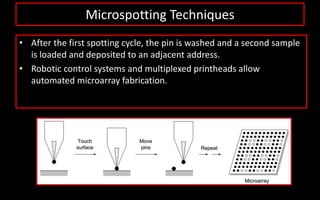The document discusses DNA microarrays, including their applications, history, major steps, methods of construction, and technical issues. DNA microarrays allow analysis of gene expression across thousands of genes simultaneously. They have been used since the 1990s and are constructed by attaching DNA probes to a solid surface in a high-density array. Two main types are cDNA-based microarrays using amplified cDNA and oligonucleotide-based arrays like Affymetrix GeneChips containing short DNA sequences.



![In 1982 RNA was isolated from normal and cancer tissue of mice,
cDNA synthesized, cloned on E. Coli and 378 colonies were arrayed.
Scientists at the California-based biotech company Affymetrix produce
the first DNA chips. (1991) [publically since 1996]
Quantitative monitoring of gene expression patterns with a
complementary DNA microarray. (Science 1995)
microarrays for gene expression profiling was used in 1995 using
complete eukaryotic genome (Saccharomyces cerevisiae) on a
microarray chip. (Published in 1997)](https://image.slidesharecdn.com/microarray10511-171221075332/85/Microarray-full-detail-4-320.jpg)






























